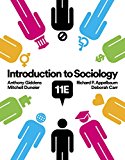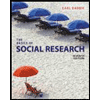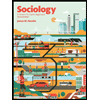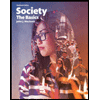Sociology Chapter 1
pdf
keyboard_arrow_up
School
Pennsylvania State University *
*We aren’t endorsed by this school
Course
001
Subject
Sociology
Date
Apr 3, 2024
Type
Pages
12
Uploaded by CountMetal15062
Understanding Sociology
Sociology:
the scientific study of social behavior and human groups
●
Focuses on social relationships
●
How relationships influence people’s behavior
●
How relationships develop and change
●
Involves the organized, systematic study of phenomena to enhance understanding
Sociological imagination:
an awareness of the relationship between an individual and the wider
society, both today and in the past.
●
Important aspect is the ability to view one’s own society as an outsider would
○
Sporting events
■
The type of sporting event varies based on one part of the world to
another
●
Divorce
○
C. Wright MIlls advocated to view divorce as a societal concern rather than an
individual one
●
Can view society from a broader lens
Use your sociological imagination
●
You are walking down the street in your city or hometown. In looking around you, you
can’t help noticing that half or more of the people you see are overweight. How do you
explain your observation? If you were C. Wright Mills, how do you think you would
explain it?
○
If I was C. Wright Mills, I would interpret the problem of obesity as a societal
problem instead of an individual one because the private issues come from the
roots of public issues like accessing affordable, healthy food.
Science:
the body of knowledge obtained by methods based on systematic observation
Natural science:
the study of the physical features of nature and the ways in which they interact
and change.
Social science:
the study of the social features of humans and the ways in which they interact
and change.
●
Sociologists study the influence that society has on people’s attitudes and behavior and
the ways in which people interact and shape society
●
The range of sociological issues is extremely vast
●
Sociology considers how the impact of global issues (ex: climate change) are not evenly
felt by socioeconomic status
●
Our personal theories and opinions come from common sense
○
Common sense deviates from:
■
Experiences
■
Conversations
■
What we read
■
What we see
●
Common sense is not always reliable because it is based on commonly held beliefs
instead of systematic, factual analysis
●
Sociologists do not just accept something as a fact because it is considered common
sense, or “everyone knows it”
○
They rely on science
Thinking Critically
●
What aspects of the social and work environment in a fast-food restaurant would be of
particular interest to a sociologist? How would the sociological imagination help in
analyzing the topic?
○
A sociologist would have particular interest in the socioeconomic status of both
the workers and people who go to the fast-food restaurant and see if they have
any relation. The sociological imagination would help with an analysis of this
topic because they can scientifically verify how a small aspect of society
(social/work environment) affects society as a whole
What is Sociological Theory?
Theory:
a set of statements that seeks to explain problems, actions, or behavior
●
Effective theories can have both explanatory and predictive power
●
Durkheim looked at the varying suicide rates and their variation from country to country
○
From this, he published
Suicide
in 1897
○
Instead of focusing on inherited tendencies, he focused on social factors
○
He concluded that suicide rates were reflected by how integrated people were in
society
○
Durkheim’s theory has
predictive power
since he believes that the suicide rates
are correlated to social and economic changes
Use Your Sociological
Imagination
●
If you were Durkheim’s successor in his research on suicide, how would you investigate
the factors that may explain the increase in suicide rates among people age 55 and older
in the United States today?
○
The factors that I would investigate are whether the person is married or not, has
divorced and how many times, and what their socioeconomic status is
●
A theory is not a final statement about human behavior
Thinking Critically
●
Can you think of any other explanation for the high suicide rate in Las Vegas? Does that
explanation agree with Durkheim’s theory?
○
Las Vegas is a social hotspot for tourists, but it may lead to social isolation for the
locals who live their year-round. The social isolation coincides with a social
change, and this may explain the increased suicide rate.
The Development of Sociology
Auguste Comte (1798-1857)
●
Believed that theoretical science of society and systematic investigation of behavior
were needed in order to improve society
●
The term sociology originates from him
Harriet Martineau (1802-1876)
●
Translated Comte’s works
●
Wrote the first book on sociological methods
●
Spoke out in favor of women’s rights, freeing slaves, and the freedom of religion
●
Researched the nature of female employment
Herbert Spencer (1820-1903)
●
He did not want to correct society, but he did want a better understanding of it
●
His ideas were popular when he was alive
●
Suggested that since societies are bound to change eventually, an individual should not
be critical to present social arrangements or work actively for social change
Émile Durkheim (1858-1917)
●
Appointed one of the first sociology professors in France
●
Had important theoretical work on suicide
●
Concluded that religion reinforces a group’s solidarity
●
Anomie:
Durkheim’s term for the loss of direction felt in a society when social control of
individual behavior has become ineffective
○
Believed that the growing division of labor in industrial societies led to anomie
Your preview ends here
Eager to read complete document? Join bartleby learn and gain access to the full version
- Access to all documents
- Unlimited textbook solutions
- 24/7 expert homework help
○
Anomie leads to people being so confused and unable to cope with the new
social environment that they resort to suicide
●
Believed that sociology should provide direction for social change (like Comte)
Max Weber (1864-1920)
●
Verstehen:
the German word for “understanding or “insight”; used by Max Weber to
stress the need for sociologists to take into account the subjective meanings people
attach to their actions
●
Stated that fully comprehending behavior means that we must learn the subjective
meanings people attach to their actions
●
Ideal Type:
a construct or model for evaluating specific cases
○
He identified bureaucracy as an ideal type
Karl Marx (1818-1883)
●
Fled to France after a paper he wrote while in Germany was suppressed
●
Met Friedrich Engels in Paris, and he made a lifelong friendship with him
○
They attended secret meeting of illegal coalition of labor unions known as the
Communist League
●
The Communist Manifesto
○
The masses of people with no resources other than their labor should unite to
fight for the overthrow of capitalist societies
○
“The history of all hitherto existing society is the history of class struggles
…
The proletarians have nothing to lose but their chains. They have a world to win.”
●
Went back to Germany and got expelled; this led him to move to England
○
Became an outsider in British society
●
Believed that a system of economic, social, and political relationships maintained the
power and dominance of the owners over the workers
●
His writings inspired communist revolutions in Russia, China, Cuba, and Vietnam
Thinking Critically
●
What influences do Marx’s ideas have on current social and political issues?
○
There is frequent criticism of capitalism in many countries as well as the
existence of communism in many countries. His ideas that capitalism has
inherent flaws that can only be fixed with communism still apply to this day.
W.E.B. DuBois (1868-1963)
●
Believed knowledge was essential in combating prejudice and achieving tolerance and
justice
●
Saw the importance of religion to society
●
Believed that granting full political rights to black people was essential to their
socioeconomic progress
●
Many of his ideas challenged the status quo, so it was difficult for him to find a receptive
audience
●
Helped to found the NAACP
●
Double consciousness:
the division of an individual’s identity into two or more social
realities
○
Describes the experience of being black in a white America
Charles Horton Cooley (1864-1929)
●
Increased the understanding of groups of relatively small size
Jane Addams
●
Settlement houses:
community centers in poor urban areas
○
Co-founded the Hull House
●
Member of the American Sociological Society
●
In attempts to create a more egalitarian society and assist underprivileged people, she
did social service work and political activism
●
Prevented racial segregation in Chicago public schools
Robert Merton (1910-2003)
●
People attempt to earn success differently
○
Innovators: people who pursue material wealth with illegal means (robbery,
burglary, and extortion)
●
Macrosociology:
sociological investigation that concentrates on large-scale phenomena
or entire civilizations
●
Microsociology:
sociological investigation that stresses the study of small groups, often
through experimental means
●
Mesosociology:
an intermediate level of sociological analysis that focuses on formal
organizations and social movements
●
Global sociology:
a level of sociological analysis that makes comparisons between entire
nations, using entire societies as units of analysis
Pierre Bourdieu (1930-2002)
●
Write about how capital in its many forms sustains individuals and families from one
generation to the next
●
Cultural capital:
noneconomic goods, such as family background and education, which
are reflected in a knowledge of language and the arts
●
Social capital:
the collective benefit of social networks, which are built on reciprocal
trust
Thinking Critically
●
What kinds of social and cultural capital do you possess? How did you acquire them?
What keeps you from acquiring more?
○
The cultural capital I have is limited, but my family background is inherited while
my education was earned. I cannot acquire any more family background because
that is purely genetic, but the only thing in the way of obtaining more education
is myself.
○
The social capital I have is rather limited because I am younger and have not met
a very high amount of people in my life, but there is nothing stopping me from
acquiring more. As long as I can keep the trust of people, I can gain more social
capital.
Major Theoretical Perspectives
●
Some sociologists see society as stable while others see it as many groups in conflict
with one another
Functionalist Perspective:
a sociological approach that emphasizes the way in
which the parts of a society are structured to maintain its stability
●
Talcott Parsons (1902-1979)
○
Important figure in the functionalist theory’s development
○
Influenced by Durkheim and Weber
○
Saw society as a vast network of connected parts, each of which helps to
maintain the system as a whole
●
Niklas Luhmann (1927-1998)
○
Carried forward Parsons’ approach
Manifest and Latent Functions
●
Robert Merton
○
Contrasted between manifest functions and latent functions
○
Manifest functions:
an open, stated, and conscious function
○
Latent functions:
an unconscious or unintended function that may reflect hidden
purposes
Dysfunctions:
an element or process of a society that may disrupt the social system or reduce
its stability
Your preview ends here
Eager to read complete document? Join bartleby learn and gain access to the full version
- Access to all documents
- Unlimited textbook solutions
- 24/7 expert homework help
●
For instance, some prison guards see prison gangs as a function part of their jobs
because it gives the jobs more relevance since the gangs are a potential threat to
security and safety in the prison
Conflict Perspective:
a sociological approach that assumes that social behavior is
best understood in terms of tension between groups over power or the allocation
of resources, including housing, money, access to services, and political
representation
●
Became increasingly persuasive in the late 1960s
●
View that our social world is characterized by continual struggle between competing
groups
The Marxist View
●
Modern sociologists have brought attention to social inequality and how it affects
people of color
○
Significant change is required to defeat this inequality
The Feminist Perspective:
a sociological approach that views inequity in gender as central to all
behavior and organization
●
Focuses on the macro level
●
There are some radical feminist theorists who believe that the oppression of women in
inevitable
●
Ida Wells Barnett (1862-1931)
○
Researched what it meant to be black, a woman in the United States, and a black
woman in the U.S.
●
Privilege (or lack thereof) is determined by multiple social factors
○
Gender
○
Age
○
Race
○
Sexual orientation
○
Religion
●
Intersectionalities:
the interlocking matrix of domination
Queer Theory:
the study of society from the perspective of a broad spectrum of sexual
identities, including heterosexuality, homosexuality, and bisexuality
●
Michel Foucault
○
Pointed out that what is considered acceptable for human sexuality varies by
culture and time periods
●
Eve Sedgwick
○
Argued that any analysis of society is incomplete if it does not have the spectrum
of sexual identities that people accept
●
In the Obama vs. Romney presidential race, Obama had an overwhelming amount of
support from queer voters
Use Your Sociological Imagination
●
You are a sociologist who takes the conflict perspective. How would you interpret the
practice of prostitution? How would your view of prostitution differ if you took the
functionalist perspective? The feminist perspective? The perspective of queer theory?
○
If I was a sociologist and looking through the conflict perspective, prostitution
represents the economic struggles that many in society have to deal with.
○
Functionalist perspective: As long as pimps exist, prostitution can be maintained
quite sustainability regardless of its legality.
○
Feminist perspective: Due to the significant majority of prostitution being
women, it represents a consequence of the gender inequity that exists in society.
○
Queer theory: There are prostitutes with many different sexual orientations.
Technically, even though prostitution is mostly illegal (in the U.S.), prostitution
thrives more with prostitutes of more diverse sexualities.
Interactionist Perspective:
a sociological approach that generalizes about
everyday forms of social interaction in order to explain society as a whole
●
Interactionism: a sociological framework in which human beings are viewed as living in a
world of meaningful objects
○
Objects = material things, actions, other people, relationships, and symbols
■
Symbols are understood by all member of a society
●
Nonverbal communication:
the sending of messages through the use of gestures, facial
expressions, and postures
●
George Herbert Mead (1863-1931)
○
Founder of the interactionist perspective
●
Erving Goffman (1922-1982)
○
Dramaturgical approach:
a view of social interaction, popularized by Erving
Goffman, in which people are seen as theatrical performers
●
Third place:
a social setting in addition to the “first place” of home and the “second
place” of work where people routinely gather
1.
Think about acceptable third-place behavior. In what types of situations do people tend
to separate by race, class, or gender in third places?
a.
Public bathrooms are separated by gender with the exception of a family
bathroom. On planes, there are typically different classes at different prices in
which the customers are given different levels of service.
2.
What third places do you visit regularly?
a.
The third places I visit on a daily basis are my classes and the gym. The gym is not
entirely a public place because you need an id+ card to enter, but my classes are
technically public since anyone can attend.
The Sociological Approach
●
A sociologist’s theoretical orientation influences his or her approach to a research
problem in a crucial way
●
Sociologists tend to favor one particular perspective
1.
Sociologists have identified additional levels of research beyond those that Robert
Merton used. These include which of the following?
a.
Mesosociology and global sociology
2.
In the middle of the twentieth century, sociologists shifted their focus to ______.
a.
Theorizing and gathering information
3.
Robert Merton is particularly well-known for his theory that attempts to explain ______.
a.
Deviant behavior
4.
According to French sociologist Pierre Bourdieu, which of the following refers to
noneconomic goods, such as family background and education, which are reflected in a
knowledge of language and the arts?
a.
Cultural capital
5.
According to Merton, _______ use illegal or deviant means of obtaining the accepted
goal of achieving material wealth.
a.
Innovators
6.
According to French sociologist Pierre Bourdieu, the collective benefit of social
networks, which are built on reciprocal trust, is known as ______.
a.
Social capital
7.
Studying a society through the lens of large-scale phenomena would be an example of
which of the following?
a.
Macrosociology
8.
Which are the views most widely used by sociologists in examining society?
a.
The conflict, functionalist, and interactionist perspectives
9.
In the mid-twentieth century, sociologists began to focus on which of the following?
a.
Scientific methods of research and value-free interpretation of data
Your preview ends here
Eager to read complete document? Join bartleby learn and gain access to the full version
- Access to all documents
- Unlimited textbook solutions
- 24/7 expert homework help
10. The sociological perspective that focuses on how parts of society contribute to help
maintain social stability is known as the ______ perspective.
a.
Functionalist
11. Cultural capital refers to the kind of education that is valued by which of the following?
a.
The socially elite
12. Parsons believed an aspect of society that does not contribute to society's survival or
stability will ______.
a.
Not be passed on from one generation to the next
13. When you are offered a job because your uncle's best friend owns the company, you are
benefiting from what sociologist Pierre Bourdieu referred to as ______.
a.
Social capital
14. The three theoretical perspectives most widely used by sociologists are ______.
a.
Functionalist, conflict, and interactionist
15. Cow worship in Indian society, a provision of which prohibits eating beef, is a functioning
part of that country's society for which of the following reasons?
a.
The cow produces dung used for cooking fuel and fertilizer, the cow is used for
plowing fields, and the cow provides a means of producing milk
16. The unconscious or unintended functions that may reflect hidden purposes of an
institution are referred to as, ________ functions.
a.
Latent
17. The functionalist perspective emphasizes ______.
a.
How parts of a society are structured to maintain stability
18. Parsons's functionalist theory rests upon the idea that ______.
a.
Social components work together to maintain society
19. When an immigrant family arrives in a new country and engages in previously functional
behavior that no longer serves a social function in the new cultural environment, the
functionalist perspective predicts that the ______.
a.
Behavior will not be passed on to a new generation
20. Which of the following is a latent function of the automobile in American society?
a.
Manufacturing and road construction jobs
21. The sociological perspective that focuses on how parts of society contribute to help
maintain social stability is known as the ______ perspective.
22. Crime is generally viewed as a dysfunction in society, but the criminal justice system
employs millions of people to keep crime in check. Therefore, the dysfunction of crime
______.
a.
Also serves functions for society
23. The conflict perspective focuses on ______.
a.
Inequality of power and the tension between groups
24. Which theoretical perspective
best
helps shed light on the tensions and problems
society faces?
a.
Conflict
25. Karl Marx's view of social classes is
best
described as part of which of the following
sociological perspectives?
a.
Conflict
26. An element or a process of a society that may actually disrupt the social system or
reduce its stability is known as ______.
a.
Dysfunction
27. The ______ proposes that social behavior can
best
be understood by looking at tension
between groups over power or the allocation of resources.
a.
Conflict perspective
28. Which sociological perspective has as its central tenet that gender inequality is central to
all behavior and organization?
a.
Feminist
29. Which theoretical perspective takes the view that the social world is characterized by
continual struggle between competing groups?
a.
Conflict
30. Marx's view of society describes social institutions as a means of _______.
a.
Keeping some groups subservient to others
31. Which of the following concepts would
best
explain the general experience of young,
Black, lesbian women in today's society?
a.
Intersectionality
32. The study of society from the perspective of a broad spectrum of sexual identities is
known as ______.
a.
Queer theory
33. The feminist perspective is most closely aligned with the ______ perspective.
a.
Conflict
34. An interactionist sociologist would be likely to study which of the following?
a.
Behavior in small groups and how workers communicate on the job
35. Which sociologist wrote from the perspective of an African American woman and used
her analysis of society as a means of combating oppression?
a.
Ida Wells-Barnett
36. People use verbal and nonverbal symbols in social interaction.
a.
True
37. George Herbert Mead studied social issues from the interactionist point of view, thereby
gathering his information from which of the following?
a.
Small groups
38. Which of the following refers to the interlocking matrix of domination in society?
a.
Intersectionalities
39. In ______ theory, sociologists have moved beyond narrow assumptions to study
sexuality in all its forms.
a.
Queer
40. The theory that explains the methods individuals use to "put on a show" in order to
manage how others view them is called ______.
a.
Dramaturgy
41. Which of the following
best
describes the interactionist perspective?
a.
It generalizes about everyday forms of social interaction in order to explain
society as a whole.
42. Which of the following forms of symbolic interaction are forms of nonverbal
communication?
a.
Postures, facial expressions, and gestures
43. Which of the following refers to a social setting other than home and work where people
routinely gather?
a.
The third place
44. Which sociologist is widely considered to be the founder of the interactionist
perspective?
a.
George Herbert Mead
45. Which of the following statements about sociological approaches are true?
a.
Sociologists draw on all of the approaches for various purposes, and no one
sociological approach is correct by itself.
46. Comparing everyday life to theater and stage, the dramaturgical approach to sociology
was made popular by ______.
a.
Erving Goffman
47. Which of the following is the
best
example of a "third place"?
a.
A coffeehouse
48. George Herbert Mead studied social issues from the interactionist point of view, thereby
gathering his information from which of the following?
a.
Small groups
49. Although sociologists draw on all approaches for various purposes, they do tend to favor
one particular perspective over others. Which of the following statements about this
tendency is true?
a.
It influences their choice of what to study and how to study it.
Your preview ends here
Eager to read complete document? Join bartleby learn and gain access to the full version
- Access to all documents
- Unlimited textbook solutions
- 24/7 expert homework help
Related Documents
Recommended textbooks for you

Social Psychology (10th Edition)
Sociology
ISBN:9780134641287
Author:Elliot Aronson, Timothy D. Wilson, Robin M. Akert, Samuel R. Sommers
Publisher:Pearson College Div

Introduction to Sociology (Eleventh Edition)
Sociology
ISBN:9780393639407
Author:Deborah Carr, Anthony Giddens, Mitchell Duneier, Richard P. Appelbaum
Publisher:W. W. Norton & Company

The Basics of Social Research (MindTap Course Lis...
Sociology
ISBN:9781305503076
Author:Earl R. Babbie
Publisher:Cengage Learning

Criminalistics: An Introduction to Forensic Scien...
Sociology
ISBN:9780134477596
Author:Saferstein, Richard
Publisher:PEARSON

Sociology: A Down-to-Earth Approach (13th Edition)
Sociology
ISBN:9780134205571
Author:James M. Henslin
Publisher:PEARSON

Society: The Basics (14th Edition)
Sociology
ISBN:9780134206325
Author:John J. Macionis
Publisher:PEARSON
Recommended textbooks for you
 Social Psychology (10th Edition)SociologyISBN:9780134641287Author:Elliot Aronson, Timothy D. Wilson, Robin M. Akert, Samuel R. SommersPublisher:Pearson College Div
Social Psychology (10th Edition)SociologyISBN:9780134641287Author:Elliot Aronson, Timothy D. Wilson, Robin M. Akert, Samuel R. SommersPublisher:Pearson College Div Introduction to Sociology (Eleventh Edition)SociologyISBN:9780393639407Author:Deborah Carr, Anthony Giddens, Mitchell Duneier, Richard P. AppelbaumPublisher:W. W. Norton & Company
Introduction to Sociology (Eleventh Edition)SociologyISBN:9780393639407Author:Deborah Carr, Anthony Giddens, Mitchell Duneier, Richard P. AppelbaumPublisher:W. W. Norton & Company The Basics of Social Research (MindTap Course Lis...SociologyISBN:9781305503076Author:Earl R. BabbiePublisher:Cengage Learning
The Basics of Social Research (MindTap Course Lis...SociologyISBN:9781305503076Author:Earl R. BabbiePublisher:Cengage Learning Criminalistics: An Introduction to Forensic Scien...SociologyISBN:9780134477596Author:Saferstein, RichardPublisher:PEARSON
Criminalistics: An Introduction to Forensic Scien...SociologyISBN:9780134477596Author:Saferstein, RichardPublisher:PEARSON Sociology: A Down-to-Earth Approach (13th Edition)SociologyISBN:9780134205571Author:James M. HenslinPublisher:PEARSON
Sociology: A Down-to-Earth Approach (13th Edition)SociologyISBN:9780134205571Author:James M. HenslinPublisher:PEARSON Society: The Basics (14th Edition)SociologyISBN:9780134206325Author:John J. MacionisPublisher:PEARSON
Society: The Basics (14th Edition)SociologyISBN:9780134206325Author:John J. MacionisPublisher:PEARSON

Social Psychology (10th Edition)
Sociology
ISBN:9780134641287
Author:Elliot Aronson, Timothy D. Wilson, Robin M. Akert, Samuel R. Sommers
Publisher:Pearson College Div

Introduction to Sociology (Eleventh Edition)
Sociology
ISBN:9780393639407
Author:Deborah Carr, Anthony Giddens, Mitchell Duneier, Richard P. Appelbaum
Publisher:W. W. Norton & Company

The Basics of Social Research (MindTap Course Lis...
Sociology
ISBN:9781305503076
Author:Earl R. Babbie
Publisher:Cengage Learning

Criminalistics: An Introduction to Forensic Scien...
Sociology
ISBN:9780134477596
Author:Saferstein, Richard
Publisher:PEARSON

Sociology: A Down-to-Earth Approach (13th Edition)
Sociology
ISBN:9780134205571
Author:James M. Henslin
Publisher:PEARSON

Society: The Basics (14th Edition)
Sociology
ISBN:9780134206325
Author:John J. Macionis
Publisher:PEARSON